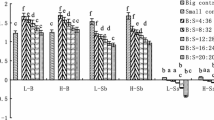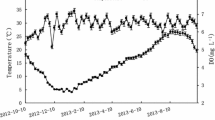Abstract
The possibility of the integrated multi-trophic aquaculture (IMTA) model consisting of Styela clava, microalgae, and Stichopus japonicus was examined in this research, in which microalgae could remove dissolvable nutrients produced by S. clava and S. japonicus to maintain the dissolvable nutrients at a lower level, and provide sufficient dissolved oxygen in the water body through photosynthesis at the same time. S. clava helped accumulate organic matter in the sediments, and the content of total organic carbon (TOC) in the sediments was significantly higher in the groups of S. clava than that in the control without ascidian. S. japonicus were able to effectively remove the particulate organic carbon and nitrogen from the sediments, and hence an obvious decrease in TOC and total nitrogen on the surface sediments. It was also found that the reproduction of bacteria on the surface sediments attributed to the biological interference of S. japonicus. It is concluded from our experiments that the IMTA system of microalgae–S. clava–S. japonicus does not have organic matter accumulated in the sediments, or the dissolved organic matter polluted, which indicates that this IMTA model is not only an aquaculture system, but also a system purifying N and P in the water body.













Similar content being viewed by others
References
Bolton JJ, Robertson-Andersson DV, Shuuluka D et al (2009) Growing Ulva (Chlorophyta) in integrated systems as a commercial crop for abalone feed in South Africa: a SWOT analysis. J Appl Phycol 21(5):575–583
Bosma RH, Verdegem MCJ (2011) Sustainable aquaculture in ponds: principles, practices and limits. Livest Sci 139(1–2):58–68
Buschmann AH, Varela DA, Hernández-González MC et al (2008) Opportunities and challenges for the development of an integrated seaweed-based aquaculture activity in Chile: determining the physiological capabilities of Macrocystis and Gracilaria as biofilters. J Appl Phycol 20(5):121–127
Crab R, Defoirdt T, Bossier P et al (2012) Biofloc technology in aquaculture: beneficial effects and future challenges. Aquaculture 356–357(1):351–356
Cruz-Suárez LE, León A, Peña-Rodríguez A et al (2010) Shrimp/Ulva co-culture: a sustainable alternative to diminish the need for artificial feed and improve shrimp quality. Aquaculture 301(1–4):64–68
FAO 2000. The state of world fisheries and aquaculture 2000
Fu WT, Wu YC, Sun LM et al (2007) Efficient bioremediation of total organic carbon (TOC) in integrated aquaculture system by marine sponge Hymeniacidon perleve. Biotechnol Bioeng 97(6):1387–1397
GB3097-1997 (1998) Sea water quality standard. Standardization Administration of the People’s Republic of China
Gifford S, Dunstan RH, O’Connor W et al (2004) Pearl aquaculture—profitable environmental remediation. Sci Total Environ 319(1–3):27–37
Handå A, Min H, Wang X et al (2012) Incorporation of fish feed and growth of blue mussels (Mytilus edulis) in close proximity to salmon (Salmo salar) aquaculture: implications for integrated multi-trophic aquaculture in Norwegian coastal waters. Aquaculture 356–357:328–341
Jiang AL, Lin J, Wang CH (2008) Physiological energetics of Styela clava in relation to body size and temperature. Comp Biochem Phys A 149:129–136
Jiang AL, Yu Z, Wang CH (2009) Bioaccumulation of cadmium in the ascidian Styela clava. Afr J Mar Sci 31(3):125–132
Khoi LV, Fotedar R (2011) Integration of western king prawn (Penaeus latisulcatus Kishinouye, 1896) and green seaweed (Ulva lactuca Linnaeus, 1753) in a closed recirculating aquaculture system. Aquaculture 322–323:201–209
Khoi LV, Fotedar R (2012) Integration of blue mussel (Mytilus edulis Linnaeus, 1758) with western king prawn (Penaeus latisulcatus Kishinouye, 1896) in a closed recirculating aquaculture system under laboratory conditions. Aquaculture 354–355(2):84–90
Konnerup D, Trang NTD, Brix H (2011) Treatment of fishpond water by recirculating horizontal and vertical flow constructed wetlands in the tropics. Aquaculture 313(1–4):57–64
MacDonald BA, Robinson SMC, Barrington KA (2011) Feeding activity of mussels (Mytilus edulis) held in the field at an integrated multi-trophic aquaculture (IMTA) site (Salmo salar) and exposed to fish food in the laboratory. Aquaculture 314(1–4):244–251
Malzahn AM, Hantzsche F, Schoo KL et al (2010) Differential effects of nutrient-limited primary production on primary, secondary or tertiary consumers. Oecologia 162(1):35–48
Neori A (2008) Essential role of seaweed cultivation in integrated multi-trophic aquaculture farms for global expansion of mariculture: an analysis. J Appl Phycol 20:567–570
Neori A, Msuya FE, Shauli L et al (2003) A novel three-stage seaweed (Ulva lactuca) biofilter design for integrated mariculture. J Appl Phycol 15(6):543–553
Nobre AM, Robertson-Andersson D, Neori A et al (2010) Ecological–economic assessment of aquaculture options: comparison between abalone monoculture and integrated multi-trophic aquaculture of abalone and seaweeds. Aquaculture 306(1–4):116–126
Paul BG, Vogl CR (2011) Impacts of shrimp farming in Bangladesh: challenges and alternatives. Ocean Coast Manage 54(3):201–211
Price NM, Harrison GI, Hering JG et al (1989) Preparation and chemistry of the artificial algal culture medium Aquil. Biol Oceanogr 6(5–6):443–461
Pronzato R, Cerrano C, Cubeddu T et al (1998) Sustainable development in coastal areas: role of sponge farming in integrated aquaculture. In Grizel H, Kesmont P (eds) Aquaculture and water: fish culture, shellfish culture and water usage. European Aquaculture Society, Special publication no. 26, pp 231–232
Ren JS, Stenton-Dozey J, Plew DR et al (2012) An ecosystem model for optimising production in integrated multitrophic aquaculture systems. Ecol Model 246(10):34–46
Ribes M, Coma R, Atkinson MJ, Kinzie RA (2005) Sponges and ascidians control removal of particulate organic nitrogen from coral reef water. Limnol Oceanogr 50(5):1480–1489
Sanz-Lázaro C, Belando MD, Navarrete-Mier F et al (2011) Effects of wild fish and motile epibenthic invertebrates on the benthos below an open water fish farm. Estuar Coast Shelf Sci 91(2):216–223
Shi J, Wei H, Zhao L et al (2011) A physical–biological coupled aquaculture model for a suspended aquaculture area of China. Aquaculture 318(3–4):412–424
Slater MJ, Jeffs AG (2010) Do benthic sediment characteristics explain the distribution of juveniles of the deposit-feeding sea cucumber Australostichopus mollis? J Sea Res 64(3):241–249
Sohel MSI, Ullah MH (2012) Ecohydrology: a framework for overcoming the environmental impacts of shrimp aquaculture on the coastal zone of Bangladesh. Ocean Coast Manage 63:67–78
State Oceanic Administration of China (2006) Technical regulations of marine chemical survey. Maritime Press, Beijing
Thompson RC, Norton TA, Hawkins SJ (2004) Physical stress and biological control regulate the producer–consumer balance in intertidal biofilms. Ecology 85(5):1372–1382
Troell M, Halling C, Neori A et al (2003) Integrated mariculture: asking the right questions. Aquaculture 226(1–4):69–90
Wang F, Dong SL, Zhang S, Pan KH (1998) Study on the respiration and excretion of Argopecten irradians and Crassostrea gigas. J Ocean Univ Qingdao 28(2):233–239 (in Chinese)
Zhang SY, Lia Gu, Wu HB et al (2011) An integrated recirculating aquaculture system (RAS) for land-based fish farming: the effects on water quality and fish production. Aquac Eng 45(3):93–102
Zhou W, Xiao H, Wang Y et al (2008) A study on the interaction between Chlorella vulgaris and heterotrophic bacteria in phycosphere. Transa Beijing Inst Technol 28(7):643–647
Acknowledgments
This study was supported by National Natural Science Foundation of China (Nos. 31070368, 31001113) and Science and Technology Department of Shandong Province (BS2010HZ022, ZR2011DL008).
Author information
Authors and Affiliations
Corresponding author
Rights and permissions
About this article
Cite this article
Ju, B., Chen, L., Xing, R. et al. A new integrated multi-trophic aquaculture system consisting of Styela clava, microalgae, and Stichopus japonicus . Aquacult Int 23, 471–497 (2015). https://doi.org/10.1007/s10499-014-9829-8
Received:
Accepted:
Published:
Issue Date:
DOI: https://doi.org/10.1007/s10499-014-9829-8




